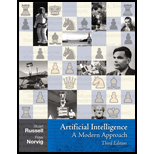
Artificial Intelligence: A Modern Approach
3rd Edition
ISBN: 9780136042594
Author: Stuart Russell, Peter Norvig
Publisher: Prentice Hall
expand_more
expand_more
format_list_bulleted
Concept explainers
Expert Solution & Answer
Chapter 1, Problem 1E
a.
Explanation of Solution
Intelligence
- Intelligence means the capacity to acquire and apply knowledge.
- It is the ability to comprehend and also profit from experience.
- It is also the ability to apply knowledge in order to perform better in an environment.
b.
Explanation of Solution
- Artificial intelligence is the study and construction of agent programs that perform well in a given environment.
- It is also known as machine intelligence and is demonstrated by machines especially computer systems.
- It is the simulation of human intelligence processes by machines especially computer systems.
c.
Explanation of Solution
Agent
- An agent is an entity that takes action in response to percepts from an environment.
- It refers to an autonomous entity which acts, directing its activity towards achieving goals.
- It could be anything which makes decisions, as a person, firm, machine or software.
d.
Explanation of Solution
Rationality
- It is the property of a system that does the right thing.
- A rational agent is an agent that has clear preferences, models uncertainty through expected values of variables or functions of variables.
- It is nothing but status of being reasonable and sensible.
e.
Explanation of Solution
Logical reasoning
- It is the process of deriving new sentences from old, such that the new sentences are true if the old ones are true.
- It refers to the ability to understand and logically work through concepts and problems.
- It is the ability to extract and work with the meaning, information and implications from the images or diagrams.
Want to see more full solutions like this?
Subscribe now to access step-by-step solutions to millions of textbook problems written by subject matter experts!
Students have asked these similar questions
4. |z + 5 - 5i| = 7
14.
dz,
C: |z❘
C: |z❘ = 0.6
ze² - 2iz
H
14.
dz,
C: |z❘
C: |z❘ = 0.6
ze² - 2iz
H
Chapter 1 Solutions
Artificial Intelligence: A Modern Approach
Ch. 1 - Prob. 1ECh. 1 - Prob. 2ECh. 1 - Are reflex actions (such as flinching from a hot...Ch. 1 - Suppose we extend Evanss ANALOGY program so that...Ch. 1 - Prob. 5ECh. 1 - How could introspectionreporting on ones inner...Ch. 1 - To what extent are the following computer systems...Ch. 1 - Prob. 8ECh. 1 - Prob. 9ECh. 1 - Prob. 10E
Knowledge Booster
Learn more about
Need a deep-dive on the concept behind this application? Look no further. Learn more about this topic, computer-science and related others by exploring similar questions and additional content below.Similar questions
arrow_back_ios
SEE MORE QUESTIONS
arrow_forward_ios
Recommended textbooks for you
 Fundamentals of Information SystemsComputer ScienceISBN:9781337097536Author:Ralph Stair, George ReynoldsPublisher:Cengage Learning
Fundamentals of Information SystemsComputer ScienceISBN:9781337097536Author:Ralph Stair, George ReynoldsPublisher:Cengage Learning Principles of Information Systems (MindTap Course...Computer ScienceISBN:9781285867168Author:Ralph Stair, George ReynoldsPublisher:Cengage Learning
Principles of Information Systems (MindTap Course...Computer ScienceISBN:9781285867168Author:Ralph Stair, George ReynoldsPublisher:Cengage Learning Principles of Information Systems (MindTap Course...Computer ScienceISBN:9781305971776Author:Ralph Stair, George ReynoldsPublisher:Cengage Learning
Principles of Information Systems (MindTap Course...Computer ScienceISBN:9781305971776Author:Ralph Stair, George ReynoldsPublisher:Cengage Learning Fundamentals of Information SystemsComputer ScienceISBN:9781305082168Author:Ralph Stair, George ReynoldsPublisher:Cengage Learning
Fundamentals of Information SystemsComputer ScienceISBN:9781305082168Author:Ralph Stair, George ReynoldsPublisher:Cengage Learning Enhanced Discovering Computers 2017 (Shelly Cashm...Computer ScienceISBN:9781305657458Author:Misty E. Vermaat, Susan L. Sebok, Steven M. Freund, Mark Frydenberg, Jennifer T. CampbellPublisher:Cengage Learning
Enhanced Discovering Computers 2017 (Shelly Cashm...Computer ScienceISBN:9781305657458Author:Misty E. Vermaat, Susan L. Sebok, Steven M. Freund, Mark Frydenberg, Jennifer T. CampbellPublisher:Cengage Learning

Fundamentals of Information Systems
Computer Science
ISBN:9781337097536
Author:Ralph Stair, George Reynolds
Publisher:Cengage Learning

Principles of Information Systems (MindTap Course...
Computer Science
ISBN:9781285867168
Author:Ralph Stair, George Reynolds
Publisher:Cengage Learning


Principles of Information Systems (MindTap Course...
Computer Science
ISBN:9781305971776
Author:Ralph Stair, George Reynolds
Publisher:Cengage Learning

Fundamentals of Information Systems
Computer Science
ISBN:9781305082168
Author:Ralph Stair, George Reynolds
Publisher:Cengage Learning

Enhanced Discovering Computers 2017 (Shelly Cashm...
Computer Science
ISBN:9781305657458
Author:Misty E. Vermaat, Susan L. Sebok, Steven M. Freund, Mark Frydenberg, Jennifer T. Campbell
Publisher:Cengage Learning